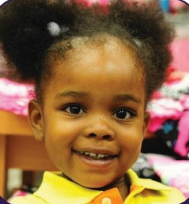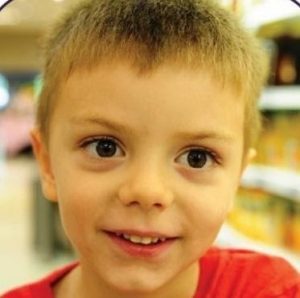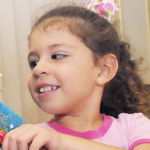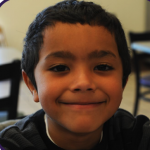1 Introduction to Planning
Learning Objectives
What Preschoolers are Like
In order to plan for children it is vital to begin with one aspect of developmentally appropriate practice, which relates to the developmental characteristics of children based on their age. Here are some representations of what children are like at each age in the preschool years.
 This is 2-year-old Aniyah. She can run and walk up and down stairs while holding on. She prefers using her right hand and makes lines and circles when she draws. She is getting better at feeding herself. She loves completing sentences in her favorite books and can match real life objects to those in books. She knows the names of body parts and follows simple instructions. She speaks in 2 to 4 word sentences and will repeat words she hears. She gets excited when around other children. She can be defiant and is showing increasing independence.
This is 2-year-old Aniyah. She can run and walk up and down stairs while holding on. She prefers using her right hand and makes lines and circles when she draws. She is getting better at feeding herself. She loves completing sentences in her favorite books and can match real life objects to those in books. She knows the names of body parts and follows simple instructions. She speaks in 2 to 4 word sentences and will repeat words she hears. She gets excited when around other children. She can be defiant and is showing increasing independence.
 Tanner is three years old. He rides a tricycle, kicks a ball, and throws a ball overhand. He turns pages in book one at a time and can build a tower of more than 6 blocks. He loves simple puzzles and playing make believe with his toys animals. He can follow two- to three-step instructions. Most of the time strangers can understand him. He now separates easily from his parents. He is learning to take turns during games. He can get upset with big changes in his routine.
Tanner is three years old. He rides a tricycle, kicks a ball, and throws a ball overhand. He turns pages in book one at a time and can build a tower of more than 6 blocks. He loves simple puzzles and playing make believe with his toys animals. He can follow two- to three-step instructions. Most of the time strangers can understand him. He now separates easily from his parents. He is learning to take turns during games. He can get upset with big changes in his routine.
 Four-year-old Isabella catches a bounced ball and can stand on one foot for two seconds She c n pour from a small pitcher. She uses scissors and has begun to copy some capital letters. She names some colours and numbers. She has begun to play board and card games. She has a sound understanding of the basic rules of grammer and can sing familiar songs from memory. She knows her first and last name. She enjoys doing new things and cooperating with other children. She struggles to distinguish real from make-believe.
Four-year-old Isabella catches a bounced ball and can stand on one foot for two seconds She c n pour from a small pitcher. She uses scissors and has begun to copy some capital letters. She names some colours and numbers. She has begun to play board and card games. She has a sound understanding of the basic rules of grammer and can sing familiar songs from memory. She knows her first and last name. She enjoys doing new things and cooperating with other children. She struggles to distinguish real from make-believe.
 Mateo is five years old. He can skip and do a somersault. He loves swinging and climbing. When he draws a person it has six body parts. He prints his name and some other letters and numbers. He can count more than ten objects. He speaks very dearly in sentences of more than five words. He loves to tell stories. He is aware that he is a boy. He now understands what is real and what is make-believe.
Mateo is five years old. He can skip and do a somersault. He loves swinging and climbing. When he draws a person it has six body parts. He prints his name and some other letters and numbers. He can count more than ten objects. He speaks very dearly in sentences of more than five words. He loves to tell stories. He is aware that he is a boy. He now understands what is real and what is make-believe.
A Vision for Children’s Learning[1]
Learning is joyful and engaging. It nourishes children’s developmental health and well-being.
–Survey feedback from a Nova Scotia early childhood educator
Image of the Child
An individual’s Image of the Child—and definition of childhood itself—is influenced by that person’s experiences, culture, values, and beliefs. This image is often influenced by their own experiences as a child. Family circumstances provide children with a variety of life experiences; a child growing up in a large extended family with many siblings, cousins, aunts, and uncles who are all involved in their life has a different perspective on what family and childhood means than a child who is an only child, even though both children are equally as loved and cherished. Children come from many different family backgrounds. People all draw on a vast range of experiences to inform their own Image of the Child.
Everyone’s Image of the Child shapes their decisions and beliefs about how children learn. The image influences the types of early learning environments that are provided for children, the role of the educators in preparing early learning environments, and relationships with children and families. If an educator believes that children are capable human beings, that their ideas and interests matter, and that their natural curiosity and love of learning inspires them to explore their environments—then the early childhood environment will be designed and structured to allow children to explore, use their senses, and confidently express their own ideas and opinions.
The framework views children’s learning as dynamic, complex, and holistic. Physical, social, emotional, personal, spiritual, creative, cognitive, and linguistic aspects of learning are all interrelated. It allows children to actively construct their own understandings, act independently, and contribute to the learning of others. Children have a right to participate in making decisions that affect them and to have their ideas and opinions welcomed, respected, and valued. Respecting these rights encourages children to share their ideas with confidence, and listen to and respect the ideas and opinions of others.
The Principles, Practices, and Learning Goals, Objectives, and Strategies described in this document are based on children as eager and avid learners, with individual strengths, capacities, and interests.
This image sets out expectations and responsibilities for educators to be:
- knowledgeable about child development
- respectful and responsive to children
- inclusive in their interactions with children and their families
- reflective of the communities where children and families live
- respectful of the cultures, languages and traditions of children
In many ways, the image of the child reflects not only a person’s beliefs about children and childhood, but also their beliefs about what is possible and desirable for human life at the individual, social, and global levels.[2]
Early childhood pedagogy
The term pedagogy is a fairly new term to educators across Nova Scotia. The term pedagogy stems from the Greek terms paÍs (child) and ágõ (to lead, to guide). Pedagogy refers to the holistic nature of an educator’s professional practice, especially those aspects that involve building and nurturing relationships. Early childhood pedagogy is different than a program plan, or defined activities intended to produce a defined outcome. It encourages educators to ask questions—about what they do, and why—and what impact their decisions have on how children learn. Pedagogy informs curriculum decision-making, and the facilitation of learning in a rich and inviting child-centered environment.
image
Early childhood pedagogy is not focused on merely providing experiences for children. It also encourages educators to observe children, engage in conversations, and guide children’s activities based on what they learn. In this way, the curriculum is co-constructed by children and educators. At the same time, educators explore and learn from families and communities, which helps to inform the construction of curriculum.
When educators view children as capable learners and establish respectful and caring relationships with them and their families, everyone works together to co-construct curriculum and learning experiences relevant to children in their local context. These experiences gradually expand children’s knowledge and understanding of the world. Professional judgement is a key component of early childhood pedagogy, and central to facilitating children’s learning. It requires educators to be reflective and intentional, to consider what they do, why they practice as they do, and how their actions impact children and their families. Professional judgement is driven by a vision of children’s potential.
In making professional judgements, educators weave together their:
- professional knowledge of child development, children’s learning, and skills to guide children’s learning in an intentionally planned play-based environment
- knowledge of children, families and communities, and cultural traditions
- awareness of how their beliefs, values, and Image of the Child impact children’s learning
Nova Scotia’s early learning framework is a social pedagogical framework that emphasizes relationships and experiences. It builds on developmental (Is this appropriate for a two-year old’s stage of development? What activities would help to develop these skills for three-year olds?), and socio-cultural perspectives (What do I need to consider about this child’s family and cultural background? Are the books in our library representative of the families and cultures of the children in the program?), and emphasizes the need for fairness, justice and equity for all children (Do all children have the same chance for success at this activity? Is the language we use free of bias about gender, race?).
A social pedagogical approach recognizes the context of children’s learning and the importance of attending to the today-ness of children’s lives and their diverse personal, social, and cultural experiences. A curriculum grounded in this approach has the simultaneous effect of promoting overall well-being and capacity for learning. [3]
Attribution
Chapter adapted from Introduction to Planning for Preschoolers in Introduction to Curriculum for Early Childhood Education by Jennifer Paris, Kristin Beeve, & Clint Springer. College of the Canyons. CC BY license.
New content added from pages 9-11 in Capable, Confident, and Curious: Nova Scotia’s Early Learning Curriculum Framework.
- Province of Nova Scotia Department of Education and Early Childhood DevelopmenT. (2018). Capable, Confident, and Curious: Nova Scotia’s Early Learning Curriculum Framework. https://www.ednet.ns.ca/docs/nselcurriculumframework.pdf ↵
- British Columbia Ministry of Health and the Ministry of Children and Family Development Early Learning Advisory Group. (2008). British Columbia Early Learning Framework (p.4). Victoria, BC: Government of British Columbia. www2.gov.bc.ca/gov/content/education-training/early- learning/teach/early-learning-framework ↵
- University of New Brunswick Early Childhood Research and Development Team. (2008). New Brunswick Curriculum Framework for Early Learning and Child Care—English (p.183). Fredericton, NB: Department of Social Development, Government of New Brunswick. www2.gnb.ca/content/
gnb/en/departments/education/elcc/content/curriculum/curriculum_framework.html ) ↵

